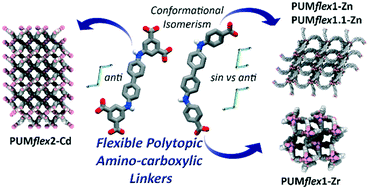Structural, thermal and topological characterization of coordination networks containing flexible aminocarboxylate ligands with a central biphenylene scaffold†
Abstract
Herein, four different coordination networks were isolated and structurally characterized by combining two aminocarboxylate ligands, 4,4′-[biphenyl-4,4′-diylbis(azanediyl)]dibenzoic acid and 5,5′-[biphenyl-4,4′-diylbis(azanediyl)]diisophthalic acid (H2L1 and H4L2, respectively), with different transition metals (Zn(II), Zr(IV) and Cd(II)) under solvothermal conditions. The reaction between H2L1 and Zn(NO3)2·6H2O led to two different coordination networks. In PUMflex1-Zn, which has the formula {[Zn4O(L1)3(DMF)2](DMF)5}n·(DMF)x, the ligand always displays a syn conformation (with respect to the central biphenylene scaffold), whereas in the polymorph PUMflex1.1-Zn, one of the three ligands composing the asymmetric unit adopts an anti conformation. Although the two supramolecular isomers have equivalent stoichiometry and dimensionality, they show different topologies and entanglement types: parallel polycatenation of the 63-hcb and 2-fold interpenetration of the 44-sql layers, respectively. In the case of PUMflex1-Zr, with the formula {[Zr6O4(OH)8(L1)4(H2O)2]n·(DMF)x, H2L1 exclusively adopts the syn conformation, forming 1D-chains of rugby-ball shaped aggregates (topological type 2,8C1) interconnected through H-bonds with water molecules. In contrast, H4L2 behaves as a dianionic ligand in PUMflex2-Cd, with the formula [Cd(κ2-COO)2(DMF)3(DMF)]n, forming 1D zig-zag chains connected through the N–H⋯O![[double bond, length as m-dash]](https://www.rsc.org/images/entities/char_e001.gif) C(OH) H-bonds to provide planar layers of sql topology. In all cases, the ability of the amine functions to interact with the H-bond active guests is structurally highlighted by the recurrent N–H⋯ODMF interaction modelled in the X-ray structures.
C(OH) H-bonds to provide planar layers of sql topology. In all cases, the ability of the amine functions to interact with the H-bond active guests is structurally highlighted by the recurrent N–H⋯ODMF interaction modelled in the X-ray structures.

- This article is part of the themed collection: Introducing the CrystEngComm Advisory Board and their research


 Please wait while we load your content...
Please wait while we load your content...